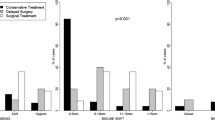Abstract
Background
Limited documentation exists about how frequently radiologically visible rebleeding occurs with abusive subdural hemorrhages (SDH). Likewise, little is known about rebleeding predispositions and associated symptoms.
Objective
To describe the frequency of subdural rebleeding after abusive head trauma (AHT), its predispositions and clinical presentation.
Materials and methods
We evaluated children with SDHs from AHT who were reimaged within a year of their initial hospitalization, retrospectively reviewing clinical details and imaging. We used the available CT and MR images. We then performed simple descriptive and comparative statistics.
Results
Fifty-four of 85 reimaged children (63.5%) with AHT-SDH rebled. No child had new trauma, radiologic evidence of new parenchymal injury or acute neurologic symptoms from rebleeding. From the initial presentation, macrocephaly was associated with subsequent rebleeding. Greater subdural depth, macrocephaly, ventriculomegaly and brain atrophy at follow-up were associated with rebleeding. No other radiologic findings at initial presentation or follow-up predicted rebleeding risk, although pre-existing brain atrophy at initial admission and initial chronic SDHs barely missed significance. Impact injuries, retinal hemorrhages and clinical indices of initial injury severity were not associated with rebleeding. All rebleeding occurred within chronic SDHs; no new bridging vein rupture was identified. The mean time until rebleeding was recognized was 12 weeks; no child had rebleeding after 49 weeks.
Conclusion
Subdural rebleeding is common and occurs in children who have brain atrophy, ventriculomegaly, macrocephaly and deep SDHs at rebleed. It usually occurs in the early months post-injury. All children with rebleeds were neurologically asymptomatic and lacked histories or clinical or radiologic findings of new trauma. Bleeds did not occur outside of chronic SDHs. We estimate the maximum predicted frequency of non-traumatic SDH rebleeding accompanied by acute neurological symptoms in children with a prior abusive SDH is 3.5%.



Similar content being viewed by others
Change history
22 May 2020
The original article included a statement which is not fully accurate. This correction clarifies the original statement.
References
Hymel KP, Jenny C, Block RW (2002) Intracranial hemorrhage and rebleeding in suspected victims of abusive head trauma: addressing the forensic controversies. Child Maltreat 7:329–348
(2013) Notice of disciplinary action: Member censure. AANS Neurosurg 22. http://v1archives.aansneurosurgeon.org/210613/8/3268. Accessed 1 May 2019
Dias MS, Backstrom J, Falk M, Li V (1998) Serial radiography in infant shaken impact syndrome. Pediatr Neurosurg 29:77–85
Wuerfel nee Tysiak E, Petersen D, Gottschalk S et al (2012) Progression of chronic subdural hematomas in an infant boy after abusive head trauma. Eur J Paediatr Neurol 16:736–739
Bradford R, Choudhary AK, Dias MS (2013) Serial neuroimaging in abusive head trauma: timing of injuries. J Neurosurg Pediatr 12:110–119
Nomura S, Kashiwagi S, Fujisawa H et al (1994) Characterization of local hyperfibrinolysis in chronic subdural hematomas by SDS-PAGE and immunoblot. J Neurosurg 81:910–913
Ito H, Yamamoto S, Saito K et al (1987) Quantitative estimation of hemorrhage in chronic subdural hematoma using 51Cr erythrocyte labeling method. J Neurosurg 100:862–864
Zouros A, Bhargava R, Hoskinson M, Aronyk KE (2004) Further characterization of traumatic subdural collections of infancy. J Neurosurg Pediatr 100:512–518
Berger RP, Fromkin JB, Stutz H et al (2011) Abusive head trauma in a time of increased unemployment a multicenter analysis. Pediatrics 128:637–643
(2019) Tools and calculators. BC Children’s Hospital. http://endodiab.bcchildrens.ca/ForProfessionals/AnthropometricCalculators.htm. Accessed 10 June 2019
O’Hayon BB, Drake JM, Ossip MG et al (1998) Frontal and occipital horn ratio: a linear estimate of ventricular size for multiple imaging modalities in pediatric hydrocephalus. Pediatr Neurosurg 29:245–249
Sieswerda-Hoogendoorn T, Postema FAM, Verbaan D et al (2014) Age determination of subdural hematomas with CT and MRI: a systematic review. Eur J Radiol 83:1257–1268
Stoodley M, Weir B (2000) Contents of chronic subdural hematoma. Neurosurg Clin N Am 11:425–434
Adamsbaum C, Morel B, Ducot B et al (2014) Dating the abusive head trauma episode and perpetrator statements: key point for imaging. Pediatr Radiol 44:S578–S588
Vezine G (2009) Assessment of the nature and age of subdural collections in nonaccidental head injury with CT and MRI. Pediatr Radiol 39:586–590
Feldman KW, Sugar NF, Browd SR (2015) Initial clinical presentation of children with acute and chronic vs. acute subdural hemorrhage due to abusive head trauma. J Neurosurg Pediatr 16:177–185
Lee K-S (2004) Natural history of chronic subdural hematoma. Brain Inj 18:351–358
Hanley JA, Lippman-Hand A (1988) If nothing goes wrong, is everything alright? J Am Med Assoc 249:1743–1745
Acknowledgments
The Matty Eappen Foundation provided partial funding for the parent epidemiology study that provided some of the AHT subjects, but the foundation had no role in the current study design or execution, or the development of this manuscript.
Author information
Authors and Affiliations
Corresponding author
Ethics declarations
Conflicts of interest
Drs. Metz, Brown and Feldman have provided legal consultation and testimony in child abuse cases.
Additional information
Publisher’s note
Springer Nature remains neutral with regard to jurisdictional claims in published maps and institutional affiliations.
Rights and permissions
About this article
Cite this article
Wright, J.N., Feyma, T.J., Ishak, G.E. et al. Subdural hemorrhage rebleeding in abused children: frequency, associations and clinical presentation. Pediatr Radiol 49, 1762–1772 (2019). https://doi.org/10.1007/s00247-019-04483-5
Received:
Revised:
Accepted:
Published:
Issue Date:
DOI: https://doi.org/10.1007/s00247-019-04483-5




